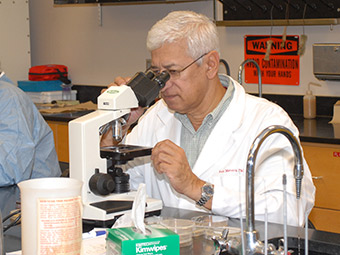Effects of mesozooplankton removal and ammonium addition on planktonic trophic structure during a bloom of the Texas ‘brown tide’: a mesocosm study
Document Type
Article
Publication Date
2-1-2003
Abstract
A bloom of the alga Aureoumbra lagunensis, known as the Texas ‘brown tide’, persisted in the Laguna Madre of Texas for most of the 1990s. The dominant mesozooplankter in Laguna Madre, Acartia tonsa, does not feed on A. lagunensis, and during blooms there are few other suitably sized phytoplankton cells available to feed on. We hypothesized that these copepods increased their feeding on microzooplankton, thereby reducing grazing pressure by microzooplankton on A. lagunensis and contributing to the persistence of this bloom. A mesocosm experiment was carried out to test this hypothesis during the summer of 1999. Twelve fiberglass corral-type mesocosms were deployed in the field for 16 days, each enclosing ∼1.2 m3 of Laguna Madre water and 1.1 m2 of natural benthos. Mesozooplankton were removed from six mesocosms with a 153 μm mesh dip net every 4 days; the other six mesocosms were treated in the same way, except that the contents of the net were returned to the mesocosm. For each zooplankton treatment, half of the mesocosms were dosed with ∼40 μm NH4 at 4 day intervals, and half received no additions. Phytoplankton populations in these mesocosms at the start of the experiment were dominated by A. lagunensis and the cyanobacterium Synechococcus spp. Growth rates of A. lagunensis were higher in mesocosms without ammonium additions, providing no evidence for nitrogen limitation. Acartia tonsa populations were reduced by ∼50% in the zooplankton removal mesocosms, and ciliate populations were significantly higher. The increase in ciliate population had no significant impact on A. lagunensis population dynamics, however, providing no evidence to support the hypothesis that a trophic cascade reducing microzooplankton populations contributed to the persistence of the brown-tide bloom. In contrast, populations of Synechococcus sp. showed evidence of both ‘top–down’ and ‘bottom–up’ control; they grew faster in nutrient addition mesocosms and had lower populations in mesocosms with increased densities of ciliate grazers.
Recommended Citation
Edward J. Buskey, Hudson Deyoe, Frank J. Jochem, Tracy A. Villareal, Effects of mesozooplankton removal and ammonium addition on planktonic trophic structure during a bloom of the Texas ‘brown tide’: a mesocosm study, Journal of Plankton Research, Volume 25, Issue 2, February 2003, Pages 215–228, https://doi.org/10.1093/plankt/25.2.215
Publication Title
Journal of Plankton Research
DOI
10.1093/plankt/25.2.215



Comments
Copyright © 2003, Oxford University Press